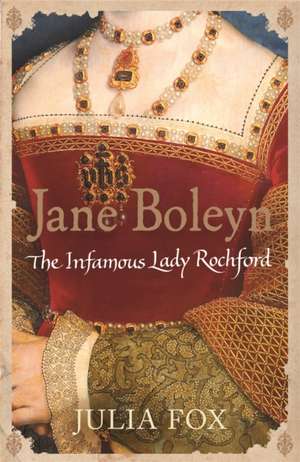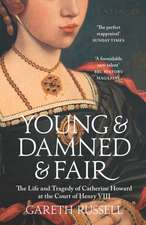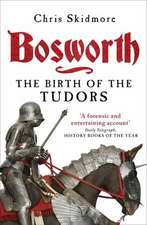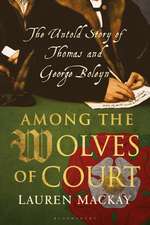Jane Boleyn
Autor Julia Foxen Limba Engleză Paperback – 2 apr 2009
| Toate formatele și edițiile | Preț | Express |
|---|---|---|
| Paperback (2) | 55.09 lei 3-5 săpt. | +29.72 lei 4-10 zile |
| Orion Publishing Group – 2 apr 2009 | 55.09 lei 3-5 săpt. | +29.72 lei 4-10 zile |
| BALLANTINE BOOKS – 28 feb 2009 | 120.71 lei 3-5 săpt. |
Preț: 55.09 lei
Preț vechi: 70.93 lei
-22% Nou
Puncte Express: 83
Preț estimativ în valută:
10.54€ • 10.94$ • 8.79£
10.54€ • 10.94$ • 8.79£
Carte disponibilă
Livrare economică 04-18 martie
Livrare express 15-21 februarie pentru 39.71 lei
Preluare comenzi: 021 569.72.76
Specificații
ISBN-13: 9780753823866
ISBN-10: 0753823861
Pagini: 416
Ilustrații: Illustrations (some col.), col. map, ports. (chiefly col.)
Dimensiuni: 130 x 198 x 30 mm
Greutate: 0.34 kg
Editura: Orion Publishing Group
Locul publicării:London, United Kingdom
ISBN-10: 0753823861
Pagini: 416
Ilustrații: Illustrations (some col.), col. map, ports. (chiefly col.)
Dimensiuni: 130 x 198 x 30 mm
Greutate: 0.34 kg
Editura: Orion Publishing Group
Locul publicării:London, United Kingdom
Notă biografică
Julia Fox has a degree in history from the University of London, where she has taught for a number of years, specializing in the Tudors and in the nineteenth century. She is married to the historian John Guy and lives in the U.K. Jane Boleyn is her first book.
Extras
Chapter 1
Childhood
It was time to go. The horses shifted and stamped restlessly. They always seemed to know when a long journey was imminent. The carts were laden with fashionable clothes, domestic items, everything needed to make life comfortable. Servants and escorts were ready too. For Lord Morley’s daughter, Jane Parker, a new life was about to begin. She rode out toward London, leaving her family home at Great Hallingbury behind.
Until now, the Tudor mansion built by Lord Morley had been her world. The solid, red-bricked house replaced an earlier Morley dwelling that had nestled in the same Essex village for over three hundred years. It was huge, a magical place for giggling children to hide and play. Scattered among the richly carved oak furniture and plate inside the building were many reminders of Lord Morley’s mother, Alice Lovel. When she died in 1518, Alice made generous bequests to her son. Lord Morley could sleep in the bed of cloth of gold and tawny velvet she left him. He could sit in her “best chair,” which stood in the long gallery that Morley equipped with expensive linenfold paneling and tall, graceful windows. Alice’s gilt bowl emblazoned with her own coat of arms as well as that of her first husband’s was on display for all to see. An even older and more precious heirloom was the special cup with its gilt cover, which Alice said was “gotten” by her ancestors. That too was on view. One of the exquisitely embroidered wall hangings also came from her. Lord Morley had been allowed to choose whichever one he wanted from her estate. Everything fitted perfectly into his newly constructed home, which was one of the finest in the county. Its grounds were impressive too. If the weather was fine, Jane roamed happily outside in the carefully tended gardens, which stretched for over two acres. There was an orchard to provide apples, pears, and quinces for the quince marmalade that everyone loved. There was a pond surrounded by trees and stocked with fish. There was a long brick stable block and hay loft, so necessary for the Morley horses, surmounted by tall red Tudor chimneys. Whether Great Hallingbury (or Hallingbury Morley, as her father preferred to call it) was snuggling under thick snow or basking in the warm sunshine of a summer’s afternoon, the setting was idyllic, especially during those few precious years of childhood when time passes slowly and growing up seems so far away.
Just a short walk across the fields from the house was the parish church of St. Giles. It is still standing. Built largely of flint and limestone, and with a square bell tower, the church was small and intimate. The nave, forty-five feet long, with circular windows set deeply into the walls, led into the chancel through a round arch constructed of Roman bricks, for there had once been a Roman site here. It was probably in this pretty church, so much the heart of the village, that Jane was baptized. About the year 1505, the tiny girl was carried to the porch of St. Giles by her mother’s midwife. Lady Morley was not present as it was customary for mothers not to reenter society until they had been churched or purified about forty days after giving birth. With Jane’s godparents at her side, the midwife gently took her inside for the baptism itself. There, at the stone font, before the richly carved rood screen and amid the painted walls and brightly colored statues of saints, the baby was welcomed into the great Catholic fold. Lord and Lady Morley knew how important it was to have babies received into the protection of the church as quickly as possible after their birth. Life was unpredictable and diseases often struck without warning; they did not want their little daughter to fall into limbo, the dreadful nothingness that awaited the souls of unbaptized children. Everything, therefore, was correctly done. The priest blessed Jane with holy oil on her shoulders and chest, on her right hand and on her forehead. Salt was placed into her mouth so that she would be “freed from all uncleanness, and from all assault of spiritual wickedness.” She was dipped three times into the sacred water in the font. She was anointed with holy chrism. The godparents, whose names are lost to us, made their promises. They vowed to ensure that Jane’s mother and father kept her “from fire and water and other perils” and to be certain that she knew “the Pater noster, Ave and Creed, after the law of all holy church.” They told the priest the name chosen for her: she was christened Jane, possibly after her father’s sister, another Jane Parker. Family ties were always important.
As she rode away from these familiar surroundings, Jane knew just how important those ties were. She had every reason to feel pride in her lineage. Her father, Sir Henry Parker, Lord Morley, was a peer of the realm. He owned lands in Norfolk, Buckinghamshire, and Herefordshire as well as in Essex. He came from ancient stock. His ancestors had played their part in tumultuous events over the centuries, helping to quell the Peasants’ Revolt and fighting for king and country in the Hundred Years’ War against England’s traditional enemy, France. Yes, Jane could feel proud.
Of course, she knew it could all have been otherwise. The family lands and title came through Jane’s grandmother, Alice Lovel. Alice’s brother, a previous Lord Morley, died in Flanders fighting for Edward IV. However, while he had died a hero, he also died without children so his entire estate went to Alice. Girls sometimes had their uses. But Alice’s first marriage, to Sir William Parker, Jane’s grandfather, brought the family close to disaster: Sir William Parker fought on the wrong side at the Battle of Bosworth. He supported the doomed Richard III against Henry Tudor, the victorious Henry VII. Sir William survived the battle but the new king never really trusted him. His son, the young Henry Parker, the future Lord Morley and Jane’s father, was fortunate to have been brought up in the household of Lady Margaret Beaufort, Henry VII’s mother.
Stern and formidable she might be, but Lady Margaret was loyal to those she took under her wing. She was particularly concerned that the little boy should receive what she felt was his due, especially when his mother remarried after Sir William’s death. Lady Margaret paid five hundred marks (just under four hundred pounds) to Alice’s new husband, Sir Edward Howard, to make sure that young Henry Parker kept some family land, presumably at Great Hallingbury. Sir Edward adhered to the bargain and also remembered his stepson in his will of 1512. He bequeathed the manor of Morley Hall in Norfolk to his wife, Alice, for her lifetime, after which it would pass to Jane’s father. The legacy did not come without conditions, however. In exchange, Morley was required to give land worth ten marks a year to the prior and convent of Ingham in Norfolk or forfeit Morley Hall to them. Morley was lucky that Alice and Sir Edward had no children to complicate the situation even more. Sir Edward had sired two bastards for whom he did his best to provide: he asked the king to choose one; the other was allocated to Charles Brandon, Duke of Suffolk. Howard hoped their new guardians would be “good” lords to his sons, but as an extra safeguard he left the boys money to help them set “forth in the world.”
This did not, of course, affect Lord Morley or his inheritance. In fact, as far as Jane’s father was concerned, the Howard marriage, which might have proved so awkward, brought him both land and valuable connections at court. The Howards were a very influential family. Sir Edward’s father was the Duke of Norfolk, one of the leading men in the land, and Sir Edward’s sister, Elizabeth, had married Sir Thomas Boleyn. Sir Thomas was a rising star, an ideal companion to the gregarious Henry VIII, certainly a man it was advantageous to know. And he was a neighbor, for the Boleyns owned lands in Essex and Norfolk just like the Morleys. Being linked to the Boleyns brought more associations since Thomas had sisters who married into other Norfolk or Essex families. His sister Anne, for example, married Sir John Shelton, Alice married Sir Robert Clere, and Margaret married Sir John Sackville. The inter- relationships were all very complicated but Lord Morley had every reason to believe that he and his family would gain from them. And Sir Thomas Boleyn had a son, George, who was more or less Jane’s age. Who knew what time might bring?
Certainly, as she rode to London, Jane understood that her destiny lay outside the confines of Great Hallingbury. Even while she enjoyed those brief years of childhood, Jane realized that they were but a preparation for the future—hers. Lord and Lady Morley took the upbringing of their children very seriously. It was their duty. Both boys and girls must be taught all that society demanded if they were to take their rightful place when the time came. Lord Morley had a love of learning that lasted all his life. Educated at Oxford himself, he wanted a stimulating and rigorous education for his son and heir, Henry. Expertise in the classics, though, was not something to encourage in his daughters. No husband would want a wife who was more knowledgeable than himself. And so Jane’s schooling was designed to fit her for the role of a wife and mother. She stayed at home in those early years, learning how to read and write, how to supervise servants and run a large household, and how to harness the healing properties of common herbs so that she could treat everyday ailments. Then, of course, there was needlework. Jane spent hours quietly sewing and perfecting convoluted yet delicate stitches. In this she was not alone; most wealthy women excelled in this pastime. Even Queen Katherine made shirts for her husband and thought nothing of mending them herself as a sign of her love. Jane’s favorite lessons, though, were perhaps music and dancing. A talented musician himself, the king delighted in everything musical. He reveled in the highly choreographed and glittering masques performed after supper at court. In these spectacular entertainments, favorite gentlemen strutted about in elaborate costumes, performing roles as holy pilgrims, mysterious strangers, or brave knights ready to rescue damsels in distress. The prettiest and most accomplished of the ladies always got the best parts. For Jane, it was as well to be ready. Opportunities to be on show before the entire court did not come easily, even for the daughter of a peer. Chances had to be seized.
That is, naturally, if God willed it so. Religion underpinned everything. While still a child, Jane was instructed with the underlying beliefs of Catholicism. She learned about the sacrifice of Christ and the sacrament of the Mass. She took comfort in the gentle goodness of the Virgin Mary who, along with the saints, could intercede for her with God. She prayed for the pope in Rome and she prayed for the king and queen. With her rosary beads in her hands, Jane recited the prayers she was taught. And she attended the services that were conducted in the Morleys’ private chapel within the house itself. The Latin words of the Mass became familiar to her as she knelt with her relatives and servants before the altar and watched the priest use the chalice and other religious ornaments given by the late Alice Lovel. She saw the terrifyingly vivid doom pictures painted on church walls that showed the souls of the righteous led into heaven by saints, martyrs, and winged angels while the damned were dragged away to eternal torment by laughing devils and monsters. She was thankful that the Catholic Church stood between herself and the horrors of hell, for the church was invincible.
It also preserved the fabric of society and the established hierarchy. For Jane, this meant that next to the king, her father was the most revered person in her life. He was head of the family. He took all the major decisions. As she rode away from Great Hallingbury, Jane knew that one day he would arrange her betrothal and she would be expected to conform to his wishes. All families chose their children’s spouses with infinite care. Marriage was, after all, a contract. It brought material and social advantages to both sides. It was not something to be entered into lightly. But it was what she was being trained for and one day it would happen.
Of course, it would bring responsibilities. Jane only had to watch her own mother to appreciate the complexities of the life that awaited her. Alice St. John was the daughter of Sir John St. John, a prosperous and respected Bedfordshire landowner. Her wedding to Lord Morley was brokered by Lady Margaret Beaufort, Morley’s patroness and a relative of the St. Johns. Jane saw how well the match worked. Alice gave birth to at least five children: Jane herself; her sister Margaret, presumably named after Lady Margaret, who helped pay christening expenses for the Morley progeny; another sister Elizabeth; and two sons, Henry, the heir, and his brother, Francis. Childbirth was both painful and hazardous but it did not interfere very much with a noblewoman’s other duties. Although the bond between mother and baby could be as strong then as it is now, Lady Morley was not required to care for any of her offspring herself; wet-nurses and servants did that. She supervised their upbringing only in the most general of terms. In fact, Jane rarely saw her mother when she was very young, for like so many women of her station Lady Morley accompanied her husband on his visits to court, sometimes staying away from the family houses for long periods. As a peer, Lord Morley had to play his part in the affairs of state. For most nobles, this meant engaging in the dangerous jousting that the king so enjoyed and fighting in the wars against France. Morley, though, was no soldier. Eventually, he served Henry with his pen, as a writer and translator of classical texts, but in the meantime attendance at court was a painless way of proving his loyalty and doing his duty. Naturally, Lady Morley went with him. So, once she was old enough, did Jane.
Unsurprisingly, since her true importance still lay in the future, much of Jane’s early life is undocumented. There was nothing unusual or noteworthy in how she was brought up. But as a way of widening experience, it was customary for young girls of her class, while in their early teens, to be sent away from home to serve in the households of other rich noblewomen. Sir Thomas Boleyn sent his two daughters to France; little Catherine Howard, another relation of Jane’s through marriage, spent her formative years with the Duchess of Norfolk. For the Morleys, the crucial decision was not whether to let Jane go; it was her destination. The most envied situation of all for a girl was admittance to the royal court in the train of a great lady. The greatest lady of all was the queen. Mothers schemed and plotted furiously to place their daughters with her. And very possibly, this is what happened to Jane. In his series of poems, Metrical Visions, George Cavendish, who knew her personally, wrote that Jane was “brought up at court” all of her “young age.” Certainly, when Jane rode out from Great Hallingbury and left childhood behind, she traveled to a new life. And that life was centered on the court of Henry VIII with all its intrigue, jealousies, and sheer exuberant luxury. It was an environment she would never leave.
From the Hardcover edition.
Childhood
It was time to go. The horses shifted and stamped restlessly. They always seemed to know when a long journey was imminent. The carts were laden with fashionable clothes, domestic items, everything needed to make life comfortable. Servants and escorts were ready too. For Lord Morley’s daughter, Jane Parker, a new life was about to begin. She rode out toward London, leaving her family home at Great Hallingbury behind.
Until now, the Tudor mansion built by Lord Morley had been her world. The solid, red-bricked house replaced an earlier Morley dwelling that had nestled in the same Essex village for over three hundred years. It was huge, a magical place for giggling children to hide and play. Scattered among the richly carved oak furniture and plate inside the building were many reminders of Lord Morley’s mother, Alice Lovel. When she died in 1518, Alice made generous bequests to her son. Lord Morley could sleep in the bed of cloth of gold and tawny velvet she left him. He could sit in her “best chair,” which stood in the long gallery that Morley equipped with expensive linenfold paneling and tall, graceful windows. Alice’s gilt bowl emblazoned with her own coat of arms as well as that of her first husband’s was on display for all to see. An even older and more precious heirloom was the special cup with its gilt cover, which Alice said was “gotten” by her ancestors. That too was on view. One of the exquisitely embroidered wall hangings also came from her. Lord Morley had been allowed to choose whichever one he wanted from her estate. Everything fitted perfectly into his newly constructed home, which was one of the finest in the county. Its grounds were impressive too. If the weather was fine, Jane roamed happily outside in the carefully tended gardens, which stretched for over two acres. There was an orchard to provide apples, pears, and quinces for the quince marmalade that everyone loved. There was a pond surrounded by trees and stocked with fish. There was a long brick stable block and hay loft, so necessary for the Morley horses, surmounted by tall red Tudor chimneys. Whether Great Hallingbury (or Hallingbury Morley, as her father preferred to call it) was snuggling under thick snow or basking in the warm sunshine of a summer’s afternoon, the setting was idyllic, especially during those few precious years of childhood when time passes slowly and growing up seems so far away.
Just a short walk across the fields from the house was the parish church of St. Giles. It is still standing. Built largely of flint and limestone, and with a square bell tower, the church was small and intimate. The nave, forty-five feet long, with circular windows set deeply into the walls, led into the chancel through a round arch constructed of Roman bricks, for there had once been a Roman site here. It was probably in this pretty church, so much the heart of the village, that Jane was baptized. About the year 1505, the tiny girl was carried to the porch of St. Giles by her mother’s midwife. Lady Morley was not present as it was customary for mothers not to reenter society until they had been churched or purified about forty days after giving birth. With Jane’s godparents at her side, the midwife gently took her inside for the baptism itself. There, at the stone font, before the richly carved rood screen and amid the painted walls and brightly colored statues of saints, the baby was welcomed into the great Catholic fold. Lord and Lady Morley knew how important it was to have babies received into the protection of the church as quickly as possible after their birth. Life was unpredictable and diseases often struck without warning; they did not want their little daughter to fall into limbo, the dreadful nothingness that awaited the souls of unbaptized children. Everything, therefore, was correctly done. The priest blessed Jane with holy oil on her shoulders and chest, on her right hand and on her forehead. Salt was placed into her mouth so that she would be “freed from all uncleanness, and from all assault of spiritual wickedness.” She was dipped three times into the sacred water in the font. She was anointed with holy chrism. The godparents, whose names are lost to us, made their promises. They vowed to ensure that Jane’s mother and father kept her “from fire and water and other perils” and to be certain that she knew “the Pater noster, Ave and Creed, after the law of all holy church.” They told the priest the name chosen for her: she was christened Jane, possibly after her father’s sister, another Jane Parker. Family ties were always important.
As she rode away from these familiar surroundings, Jane knew just how important those ties were. She had every reason to feel pride in her lineage. Her father, Sir Henry Parker, Lord Morley, was a peer of the realm. He owned lands in Norfolk, Buckinghamshire, and Herefordshire as well as in Essex. He came from ancient stock. His ancestors had played their part in tumultuous events over the centuries, helping to quell the Peasants’ Revolt and fighting for king and country in the Hundred Years’ War against England’s traditional enemy, France. Yes, Jane could feel proud.
Of course, she knew it could all have been otherwise. The family lands and title came through Jane’s grandmother, Alice Lovel. Alice’s brother, a previous Lord Morley, died in Flanders fighting for Edward IV. However, while he had died a hero, he also died without children so his entire estate went to Alice. Girls sometimes had their uses. But Alice’s first marriage, to Sir William Parker, Jane’s grandfather, brought the family close to disaster: Sir William Parker fought on the wrong side at the Battle of Bosworth. He supported the doomed Richard III against Henry Tudor, the victorious Henry VII. Sir William survived the battle but the new king never really trusted him. His son, the young Henry Parker, the future Lord Morley and Jane’s father, was fortunate to have been brought up in the household of Lady Margaret Beaufort, Henry VII’s mother.
Stern and formidable she might be, but Lady Margaret was loyal to those she took under her wing. She was particularly concerned that the little boy should receive what she felt was his due, especially when his mother remarried after Sir William’s death. Lady Margaret paid five hundred marks (just under four hundred pounds) to Alice’s new husband, Sir Edward Howard, to make sure that young Henry Parker kept some family land, presumably at Great Hallingbury. Sir Edward adhered to the bargain and also remembered his stepson in his will of 1512. He bequeathed the manor of Morley Hall in Norfolk to his wife, Alice, for her lifetime, after which it would pass to Jane’s father. The legacy did not come without conditions, however. In exchange, Morley was required to give land worth ten marks a year to the prior and convent of Ingham in Norfolk or forfeit Morley Hall to them. Morley was lucky that Alice and Sir Edward had no children to complicate the situation even more. Sir Edward had sired two bastards for whom he did his best to provide: he asked the king to choose one; the other was allocated to Charles Brandon, Duke of Suffolk. Howard hoped their new guardians would be “good” lords to his sons, but as an extra safeguard he left the boys money to help them set “forth in the world.”
This did not, of course, affect Lord Morley or his inheritance. In fact, as far as Jane’s father was concerned, the Howard marriage, which might have proved so awkward, brought him both land and valuable connections at court. The Howards were a very influential family. Sir Edward’s father was the Duke of Norfolk, one of the leading men in the land, and Sir Edward’s sister, Elizabeth, had married Sir Thomas Boleyn. Sir Thomas was a rising star, an ideal companion to the gregarious Henry VIII, certainly a man it was advantageous to know. And he was a neighbor, for the Boleyns owned lands in Essex and Norfolk just like the Morleys. Being linked to the Boleyns brought more associations since Thomas had sisters who married into other Norfolk or Essex families. His sister Anne, for example, married Sir John Shelton, Alice married Sir Robert Clere, and Margaret married Sir John Sackville. The inter- relationships were all very complicated but Lord Morley had every reason to believe that he and his family would gain from them. And Sir Thomas Boleyn had a son, George, who was more or less Jane’s age. Who knew what time might bring?
Certainly, as she rode to London, Jane understood that her destiny lay outside the confines of Great Hallingbury. Even while she enjoyed those brief years of childhood, Jane realized that they were but a preparation for the future—hers. Lord and Lady Morley took the upbringing of their children very seriously. It was their duty. Both boys and girls must be taught all that society demanded if they were to take their rightful place when the time came. Lord Morley had a love of learning that lasted all his life. Educated at Oxford himself, he wanted a stimulating and rigorous education for his son and heir, Henry. Expertise in the classics, though, was not something to encourage in his daughters. No husband would want a wife who was more knowledgeable than himself. And so Jane’s schooling was designed to fit her for the role of a wife and mother. She stayed at home in those early years, learning how to read and write, how to supervise servants and run a large household, and how to harness the healing properties of common herbs so that she could treat everyday ailments. Then, of course, there was needlework. Jane spent hours quietly sewing and perfecting convoluted yet delicate stitches. In this she was not alone; most wealthy women excelled in this pastime. Even Queen Katherine made shirts for her husband and thought nothing of mending them herself as a sign of her love. Jane’s favorite lessons, though, were perhaps music and dancing. A talented musician himself, the king delighted in everything musical. He reveled in the highly choreographed and glittering masques performed after supper at court. In these spectacular entertainments, favorite gentlemen strutted about in elaborate costumes, performing roles as holy pilgrims, mysterious strangers, or brave knights ready to rescue damsels in distress. The prettiest and most accomplished of the ladies always got the best parts. For Jane, it was as well to be ready. Opportunities to be on show before the entire court did not come easily, even for the daughter of a peer. Chances had to be seized.
That is, naturally, if God willed it so. Religion underpinned everything. While still a child, Jane was instructed with the underlying beliefs of Catholicism. She learned about the sacrifice of Christ and the sacrament of the Mass. She took comfort in the gentle goodness of the Virgin Mary who, along with the saints, could intercede for her with God. She prayed for the pope in Rome and she prayed for the king and queen. With her rosary beads in her hands, Jane recited the prayers she was taught. And she attended the services that were conducted in the Morleys’ private chapel within the house itself. The Latin words of the Mass became familiar to her as she knelt with her relatives and servants before the altar and watched the priest use the chalice and other religious ornaments given by the late Alice Lovel. She saw the terrifyingly vivid doom pictures painted on church walls that showed the souls of the righteous led into heaven by saints, martyrs, and winged angels while the damned were dragged away to eternal torment by laughing devils and monsters. She was thankful that the Catholic Church stood between herself and the horrors of hell, for the church was invincible.
It also preserved the fabric of society and the established hierarchy. For Jane, this meant that next to the king, her father was the most revered person in her life. He was head of the family. He took all the major decisions. As she rode away from Great Hallingbury, Jane knew that one day he would arrange her betrothal and she would be expected to conform to his wishes. All families chose their children’s spouses with infinite care. Marriage was, after all, a contract. It brought material and social advantages to both sides. It was not something to be entered into lightly. But it was what she was being trained for and one day it would happen.
Of course, it would bring responsibilities. Jane only had to watch her own mother to appreciate the complexities of the life that awaited her. Alice St. John was the daughter of Sir John St. John, a prosperous and respected Bedfordshire landowner. Her wedding to Lord Morley was brokered by Lady Margaret Beaufort, Morley’s patroness and a relative of the St. Johns. Jane saw how well the match worked. Alice gave birth to at least five children: Jane herself; her sister Margaret, presumably named after Lady Margaret, who helped pay christening expenses for the Morley progeny; another sister Elizabeth; and two sons, Henry, the heir, and his brother, Francis. Childbirth was both painful and hazardous but it did not interfere very much with a noblewoman’s other duties. Although the bond between mother and baby could be as strong then as it is now, Lady Morley was not required to care for any of her offspring herself; wet-nurses and servants did that. She supervised their upbringing only in the most general of terms. In fact, Jane rarely saw her mother when she was very young, for like so many women of her station Lady Morley accompanied her husband on his visits to court, sometimes staying away from the family houses for long periods. As a peer, Lord Morley had to play his part in the affairs of state. For most nobles, this meant engaging in the dangerous jousting that the king so enjoyed and fighting in the wars against France. Morley, though, was no soldier. Eventually, he served Henry with his pen, as a writer and translator of classical texts, but in the meantime attendance at court was a painless way of proving his loyalty and doing his duty. Naturally, Lady Morley went with him. So, once she was old enough, did Jane.
Unsurprisingly, since her true importance still lay in the future, much of Jane’s early life is undocumented. There was nothing unusual or noteworthy in how she was brought up. But as a way of widening experience, it was customary for young girls of her class, while in their early teens, to be sent away from home to serve in the households of other rich noblewomen. Sir Thomas Boleyn sent his two daughters to France; little Catherine Howard, another relation of Jane’s through marriage, spent her formative years with the Duchess of Norfolk. For the Morleys, the crucial decision was not whether to let Jane go; it was her destination. The most envied situation of all for a girl was admittance to the royal court in the train of a great lady. The greatest lady of all was the queen. Mothers schemed and plotted furiously to place their daughters with her. And very possibly, this is what happened to Jane. In his series of poems, Metrical Visions, George Cavendish, who knew her personally, wrote that Jane was “brought up at court” all of her “young age.” Certainly, when Jane rode out from Great Hallingbury and left childhood behind, she traveled to a new life. And that life was centered on the court of Henry VIII with all its intrigue, jealousies, and sheer exuberant luxury. It was an environment she would never leave.
From the Hardcover edition.
Recenzii
“Fox does a splendid job in conveying life at the top of the Tudor pyramid.”—USA Today
“Engrossing . . . [Jane Boleyn] dances with devilry, opulence and deception as Tudor court intrigue swirls around Henry VIII and his various queens. . . . A sparkling chronicle, fine-tuned to the personal stories that lend texture and emotion to a biography.”—Kirkus Reviews
“Outstanding . . . A fascinating and moving read, Jane Boleyn exposes the harsh reality of Henry VIII’s court, where cleverness and ambition often led to the block.”—Amanda Foreman, author of Georgiana: Duchess of Devonshire
“Fox is an English historian [who] imbues her writing with rich detail and confident knowledge. . . . She’s given depth and character to Jane Boleyn.”—The Austin Chronicle
“Engrossing . . . [Jane Boleyn] dances with devilry, opulence and deception as Tudor court intrigue swirls around Henry VIII and his various queens. . . . A sparkling chronicle, fine-tuned to the personal stories that lend texture and emotion to a biography.”—Kirkus Reviews
“Outstanding . . . A fascinating and moving read, Jane Boleyn exposes the harsh reality of Henry VIII’s court, where cleverness and ambition often led to the block.”—Amanda Foreman, author of Georgiana: Duchess of Devonshire
“Fox is an English historian [who] imbues her writing with rich detail and confident knowledge. . . . She’s given depth and character to Jane Boleyn.”—The Austin Chronicle














